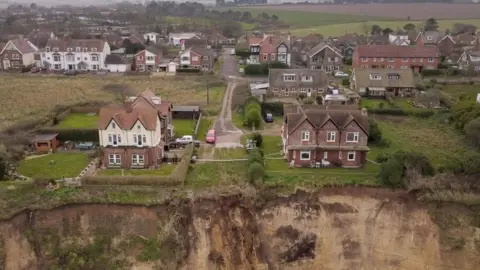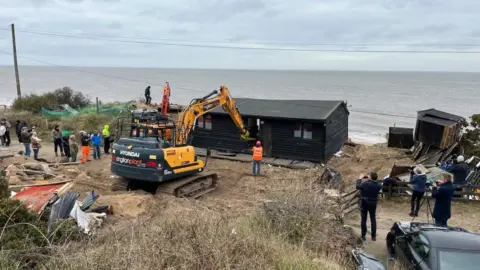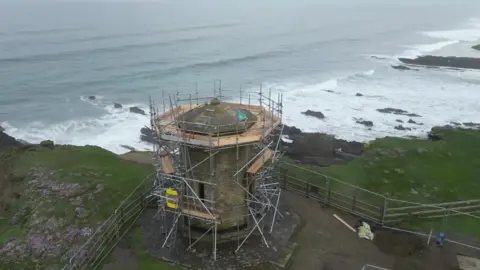Coastal erosion: Expert says moving all cliff homes is unthinkable
 Martin Barber/BBC
Martin Barber/BBCSome people living along East Anglia's coastline think the way to combat erosion might not be to move house - but to move their house.
Resident Lance Martin dragged his bungalow further inland at Hemsby, Norfolk, in a bid to save it from being demolished.
In Reydon, Suffolk, Anne Jones and her family want to build four demountable homes which can be moved inland when necessary.
But one construction expert says moving buildings will only be the solution in a few cases.
A watchtower in Bude, Cornwall, is also being dismantled and reconstructed because of coastal erosion.
Saul Humphrey, professor of sustainable construction at Anglia Ruskin University, said moving thousands of existing homes was "unthinkable" and building large numbers of moveable houses was "probably a little far-fetched".
 Historic England
Historic England"It is not as if we are talking about moving one home, or two or maybe three," said Prof Humphrey, who is based in Chelmsford.
"I think if we wind this forward and look at the probability of sea level rise, and how certain it is, it's not a King Canute game.
"We can't stop this. It's happening now and it's coming, and it's going to come at such a pace, with such impact.
"I think realistically, moving thousands of homes: unthinkable."
 Anglia Ruskin University
Anglia Ruskin UniversityIn 1972, construction engineers made news when they moved a timber-framed house in Sudbury, Suffolk, 200 yards.
Ballingdon Hall, which was built in the late 1500s, was dragged to a new location when the A131 was improved.
The feat is still remembered. Historic England posted photographer Hallam Ashley's pictures on Facebook earlier this year.
'Beggars belief'
Prof Humphrey said although it was theoretically possible to move brick buildings, the majority of homes would need to be "sacrificed" to the sea.
"It may be we have got a listed building of great heritage and charm which merits the huge expense of trying to retain it," he added
"You have the issue of landholding and do you move once every five years, so you are always near the coast, or once every 10?
"It kind of beggars belief that we would want to build in such a way."
 Martin Giles/BBC
Martin Giles/BBCProf Humphrey says the building industry has been part of the cause of climate change, and should address it by getting greener - not by moving properties.
Constructing in a more sustainable fashion - perhaps using material such as timber and hemp - was a better way forward, he suggested.

Concrete numbers
- Various scientific papers claim that the built environment is responsible for about 40% of greenhouse gas emissions
- Carbon is embedded in concrete and steel, and is emitted as a result of the heating, cooling and lighting of a building
- Concrete is estimated to cause about 8% of global CO2 emissions, and so it is often said that it would constitute the third biggest emitter in the world if it was a country
- Likewise, steel would be the fifth biggest emitter

"We have been part of the problem," said Prof Humphrey.
"The way we build needs to change and it is not happening fast enough."
 Easton Bavents Ltd
Easton Bavents LtdMr Martin's bungalow in Hemsby was dragged more than 2m (6.6ft) inland a year ago.
His home had been teetering on the edge of a rapidly eroding clifftop.
Ms Jones, as company director of Easton Bavents, is seeking permission to erect her demountable homes on her family's land east of Lowestoft Road in Reydon.
East Suffolk Council is considering the application.

Historic England said climate change was having "wide-ranging impacts".
"It is accelerating threats to vulnerable heritage sites, particularly those on the coast, and we must anticipate some physical loss of buildings and buried archaeological remains," said a spokeswoman.
"One of our main areas of focus is to develop the evidence and tools needed to help those who manage heritage to plan ahead and to make informed decisions based on the risks these places face."
The spokeswoman pointed out the watchtower's reconstruction in Bude was being funded largely by the national Lottery Heritage Fund.
She added: "Options will be site-specific, but will certainly include physically moving buildings inland in some cases where that is both technically feasible and supported by local communities."

Follow East of England news on Facebook, Instagram and X. Got a story? Email [email protected] or WhatsApp 0800 169 183
